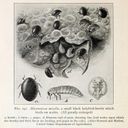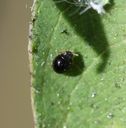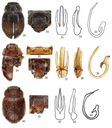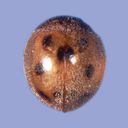Sticholotidinae
Sticholotidinae
Classification
- Phylum: Arthropoda
- Subphylum: Hexapoda
- Class: Insecta
- Order: Coleoptera
- Suborder: Polyphaga
- Superfamily: Coccinelloidea
- Family: Coccinellidae
- Subfamily: Sticholotidinae
Pronunciation
How to pronounce Sticholotidinae: /ˌstɪk.oʊ.loʊˈtɪdɪniː/
These audio files are automatically generated. While they are not always 100% accurate, they are a good starting point.
Images






Summary
Sticholotidinae is a subfamily of lady beetles characterized by their small size, which varies from 1-3 mm, and certain species in the subfamily do not possess functional wings. They are significant predators of scale insects and whiteflies, making them valuable contributors to pest management in their ecosystems.
Physical Characteristics
Size ranges from 1-3 mm. Some species do not have functional wings, which is rare among North American lady beetles.
Identification Tips
Species can be identified by their small size and wing structure, particularly noting the absence of functional wings in some candidates.
Habitat
Found in areas where scale insects and whiteflies are present, indicating a preference for specific microhabitats associated with these prey species.
Distribution
Native to North America with specific occurrences tied to local environments of their prey.
Diet
Primarily feeds on scale insects and whiteflies, making them beneficial for controlling these pest populations.
Life Cycle
Life cycle details are generally not specified, but like many beetles, they undergo a complete metamorphosis including egg, larva, pupa, and adult stages.
Ecosystem Role
Plays a role in natural pest control by feeding on scale insects and whiteflies.
Evolution
Sticholotidinae was established as a subfamily within Coccinellidae by Weise in 1901 and is part of a complex evolutionary history among lady beetles.
Similar Taxa
- Coccinellinae
- Hippodaminae
- Epilachninae
Tags
- beetle
- Coccinellidae
- lady beetle
- Sticholotidinae